The Mystique of the Ming Tombs: Explore the Feng Shui Designs of China’s Emperors
An Essential Guide to Visiting Ming Tombs
Nestled at the foot of the majestic Tianshou Mountain, the Ming Tombs (明十三陵) offer an intriguing glimpse into China’s imperial past, serving as the final resting place for 13 emperors of the Ming Dynasty. What sets these tombs apart is not just their historical significance but their stunning Feng Shui design, believed to channel the natural energies of the surrounding landscape to ensure the longevity of the dynasty. Picture a serene basin, cradled by protective hills and graced by the gentle flow of the Wenyu River—this was a conscious choice made by Emperor Zhu Di, the third Ming emperor, based on ancient beliefs that still resonate today.
In this essential guide to the Ming Tombs, you’ll discover how to navigate this sprawling necropolis, which spans over 80 square kilometers and offers a rich tapestry of history and culture. We’ll explore the must-see tombs, including the magnificent Changling and the haunting underground palace of Dingling, along with tips on the best routes to take, ticket purchasing, and transportation options. Whether you’re an avid history buff or simply seeking a peaceful escape from the bustling streets of Beijing, the Ming Tombs promise an unforgettable journey into the heart of China’s dynastic heritage.
In This Guide
- An Essential Guide to Visiting Ming Tombs
- The Rich History and Legends of Ming Tombs
- Main Highlights: What You Absolutely Can’t Miss
- Planning Your Visit: A Practical Guide
- Tickets: Prices, Booking, and Tips
- How to Get There: A Complete Transportation Guide
- Local Cuisine and Accommodation Nearby
- Frequently Asked Questions
- Final Thoughts on Your Trip
The Rich History and Legends of Ming Tombs
A Glorious Epoch: The Ming Tombs
Nestled in the tranquil foothills of Tianshou Mountain, about 50 kilometers northwest of Beijing, the Ming Tombs stand as a testament to China’s imperial grandeur and rich historical tapestry. This sprawling necropolis, also known as the “Thirteen Ming Tombs,” is the final resting place for 13 emperors, 23 empresses, concubines, and princes, marking a significant chapter in Chinese history that spanned from 1368 to 1644.
The Genesis of the Ming Tombs
The construction of the Ming Tombs began in 1409 under the reign of the Yongle Emperor, Zhu Di, who is perhaps best known for commissioning the construction of the Forbidden City. The site was chosen based on the principles of Feng Shui, as the mountainous backdrop and fertile basin were believed to provide auspicious energy and protection for the dynasty. Over the course of more than 200 years, the tombs were meticulously crafted, showcasing the architectural prowess of the time and reflecting the emperors’ desire for immortality.
Architectural Splendor
Among the 13 tombs, three are open to the public: Changling, Dingling, and Zhaoling. Changling, the largest and most impressive, houses the Yongle Emperor and his empress, Xu. This grand tomb features a stunning architectural complex that includes the Hall of Eminent Favor, supported by 60 golden Nanmu pillars, where sacrificial ceremonies were held. Visitors can marvel at the craftsmanship and the intricate details that adorn the hall, which stand as a tribute to the emperor’s legacy.
Dingling, the tomb of the Wanli Emperor, is particularly famous for its underground palace, the only one excavated among the tombs. This subterranean marvel, 27 meters deep, is adorned with diamond walls and contains three coffins guarded by a wealth of funerary objects, showcasing the opulence that characterized the Ming Dynasty.
Zhaoling, though less notable, offers a glimpse into the life of the Longqing Emperor and features the unique “Dumb Courtyard,” a serene space that serves as a transitional area to the burial chamber.
Legends of the Ming Tombs
As with many historical sites, the Ming Tombs are steeped in legends that add to their mystique. One of the most famous tales is that of the Soul Tower, which is said to guard the spirits of the emperors. Locals believe that if one pays their respects and offers a prayer, the emperors may bestow blessings upon them. Additionally, the stone statues lining the Sacred Way, guardians of the tombs, are said to come to life at night to protect their emperor, a tale that captivates the imagination of many visitors.
Another popular legend involves the Sacred Way itself, where 24 stone animals and 12 human figures stand sentinel. Folklore suggests that these statues were once living beings transformed into stone as a punishment for failing to protect the emperor. The lifelike detail of each statue adds to the enchantment, inviting visitors to ponder the lives of those who once walked these hallowed grounds.
Conclusion: A Journey Through Time
Visiting the Ming Tombs is not merely an exploration of ancient burial sites; it is a journey through time, offering a profound insight into the beliefs, customs, and artistry of the Ming Dynasty. As you wander through the Sacred Way, gaze upon the majestic tombs, and absorb the legends that echo through the ages, you’ll find yourself immersed in a rich historical narrative that continues to resonate with travelers from around the globe. The Ming Tombs remain a must-see destination for those seeking to understand China’s imperial past and the legacy of its once-mighty rulers.
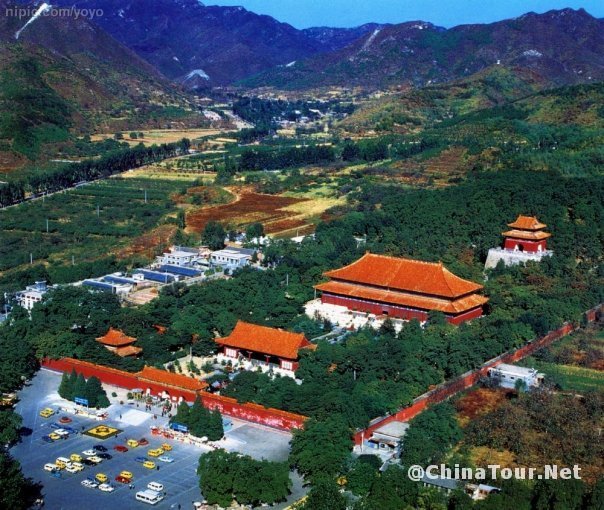
Ming Tombs.
Main Highlights: What You Absolutely Can’t Miss
Changling Tomb: The Majestic Resting Place of the Yongle Emperor
Changling is the largest and most well-preserved tomb among the Ming Tombs, dedicated to Emperor Zhu Di, also known as the Yongle Emperor. This expansive complex features stunning architecture, including the Hall of Eminent Favor, which is supported by 60 magnificent golden Nanmu columns. Here, you can immerse yourself in the history of the Ming Dynasty as you view exhibits detailing Zhu Di’s impressive reign. Tip: Make sure to take your time walking through the Hall and appreciate the intricate craftsmanship that has stood the test of time.
Dingling Tomb: A Journey Into the Underground Palace
Dingling stands out as the only tomb that boasts an excavated underground palace. This fascinating site is home to the 13th emperor, the Wanli Emperor, and features a 27-meter-deep underground chamber adorned with precious artifacts like gold crowns and luxurious silks. The experience of descending into the underground palace is surreal as you’re surrounded by the history and treasures of a bygone era. Tip: Allocate at least 45 minutes for your visit to fully explore the underground palace and its exhibition rooms that showcase over 3,000 precious funeral objects.
The Sacred Way: A Walk Through Time
The Sacred Way, known as the “Way of God,” serves as the ceremonial route for the deceased emperor’s coffin. This picturesque pathway spans 7.3 kilometers and is lined with stone statues of animals and human figures, each masterfully carved from single blocks of stone. As you stroll along this historic path, let your imagination take you back to the grandeur of Ming Dynasty funerary traditions. Tip: Don’t rush your walk; take your time to appreciate the intricate details of each statue, especially the majestic elephant, which is the largest among them.
Zhaoling Tomb: The Hidden Gem with a Unique Courtyard
Zhaoling, the tomb of the Longqing Emperor, may be less famous than Changling and Dingling, but it holds a unique charm with its secluded “Dumb Courtyard.” This tranquil space serves as a peaceful transition between the ceremonial areas and the burial chamber. The quiet ambiance allows for reflection and a deeper appreciation of the tomb’s significance. Tip: Be sure to visit the Dumb Courtyard for a moment of solitude away from the crowds, allowing you to connect with the history of this lesser-known emperor.
The Soul Tower: A Symbol of Imperial Authority
At the heart of the Ming Tombs complex stands the imposing Soul Tower, which serves as a reminder of the enduring imperial authority of the Ming Dynasty. The tower is beautifully crafted, and its elevated position offers a panoramic view of the surrounding landscape, enhancing the spiritual aura of the site. Tip: Climb to the top of the Soul Tower for an unforgettable view and to capture stunning photographs of the entire area.
The Surrounding Mountains: A Scenic Backdrop
The Ming Tombs are nestled in a basin surrounded by the majestic Tianshou Mountain, which was chosen for its auspicious Feng Shui characteristics. The scenic backdrop not only enhances the beauty of the tombs but also symbolizes the protection and blessings for the Ming Dynasty. Tip: Take a moment to appreciate the natural landscape and capture some breathtaking photos, especially during sunrise or sunset when the mountains are bathed in golden light.
Practical Tips for Your Visit
- Opening Hours: The Ming Tombs are open daily from 8:30 AM to 5:00 PM.
- Getting There: The tombs are approximately 50 kilometers northwest of Beijing. Consider taking a private car or using public transport for convenience, as there is no shuttle service between the tombs.
- Tickets: You can purchase tickets on-site or via the WeChat public account. A package ticket for the three main sites is available for a discounted price.
- Accessibility: Most areas are wheelchair-friendly, but Dingling’s underground palace is not accessible. Plan your visit accordingly.
Embark on this journey through history and explore the grandeur of the Ming Tombs, where the echoes of imperial China linger in the air, waiting to be discovered by every traveler.
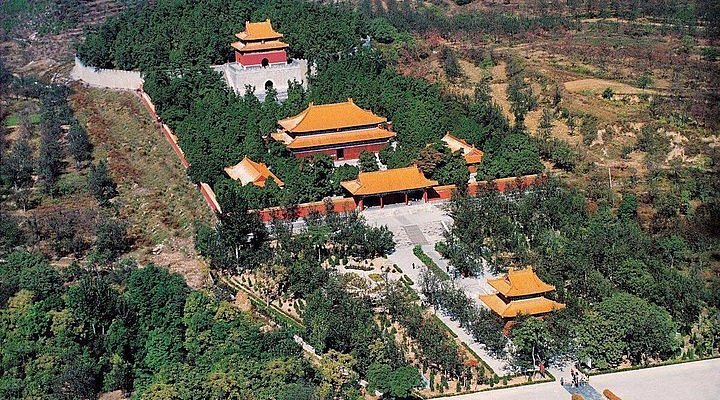
Ming Tombs.
Planning Your Visit: A Practical Guide
Your Essential Guide to Visiting the Ming Tombs
Visiting the Ming Tombs, a UNESCO World Heritage site, offers a captivating glimpse into China’s imperial history. Located just northwest of Beijing, this expansive necropolis is the final resting place for 13 emperors of the Ming Dynasty. To ensure your visit is both enjoyable and enriching, here’s a practical guide covering everything you need to know.
Best Time to Visit
The ideal time to explore the Ming Tombs is during the spring (April to June) and fall (September to October) months. These seasons provide pleasant weather and stunning natural scenery, with vibrant foliage in the fall and blooming flowers in the spring. The tombs can be quite crowded during Chinese holidays, so aim for a weekday visit if possible.
Recommended Itinerary
Here’s a suggested itinerary to help you make the most out of your visit:
-
Start Early: Arrive around 8:30 AM when the tombs open to beat the crowds.
-
Sacred Way: Begin your journey by walking the 7.3 km Sacred Way, which features impressive stone statues and animals. This scenic walk will take approximately 40 minutes.
-
Dingling Tomb: After the Sacred Way, take a bus to Dingling, the tomb of the Wanli Emperor. Allocate about 45 minutes to explore the underground palace and its fascinating artifacts.
-
Changling Tomb: Next, head to Changling, the tomb of Emperor Yongle, taking around 1 hour to appreciate its well-preserved architecture and exhibitions.
-
Zhaoling Tomb: If time allows, visit Zhaoling, the tomb of the Longqing Emperor, and explore the unique “Dumb Courtyard.”
Photography Tips
- Golden Hour: For the best lighting, visit early in the morning or late in the afternoon. The soft light enhances the beauty of the tombs and their surroundings.
- Details Matter: Capture close-ups of the intricate stone carvings along the Sacred Way and the ornate architecture of the tombs.
- Wide Shots: Don’t miss the opportunity for panoramic shots of the entire burial complex, especially at Changling, where the majestic hills serve as a stunning backdrop.
What to Wear
- Comfortable Footwear: Expect a fair amount of walking, so wear sturdy shoes suitable for uneven terrain.
- Layered Clothing: Beijing’s weather can be unpredictable. Dress in layers to adapt to changing temperatures, especially in spring and fall.
- Sun Protection: Bring a hat, sunglasses, and sunscreen, as the area can be exposed to strong sunlight, particularly during the summer months.
Insider Tips
-
Public Transport: If you’re traveling independently, consider taking the 872 bus from Deshengmen station to the Ming Tombs. This is a cost-effective way to reach the site and runs regularly.
-
Combine Visits: Pair your trip to the Ming Tombs with a visit to one of the Great Wall sections (Badaling or Mutianyu) for a full day of exploring Chinese history.
-
Plan for Lunch: Pack a picnic or familiarize yourself with local dining options nearby. There are few eateries on-site, so it’s wise to plan ahead.
-
Accessibility: Most areas are wheelchair-friendly, but note that Dingling’s underground palace is not. If traveling with mobility-impaired guests, consider customizing your itinerary to focus on accessible sites.
-
Ticket Packages: Purchase a package ticket if you plan to visit multiple tombs (Changling, Dingling, Zhaoling) to save on entrance fees. This can be done at the ticket booth or via the WeChat public account.
With this guide in hand, you’re all set to explore the rich history and stunning landscapes of the Ming Tombs. Enjoy your journey through time!
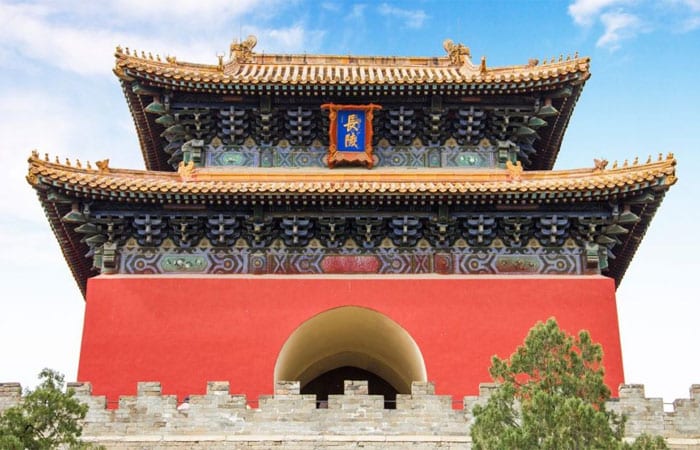
Ming Tombs.
Tickets: Prices, Booking, and Tips
When planning your visit to the Ming Tombs, knowing the ticket prices and booking options is essential for a smooth experience. Below is a comprehensive guide to ticketing, along with valuable tips on how to secure your entry.
Ticket Information
Here’s a detailed breakdown of the ticket prices for different areas within the Ming Tombs:
| Ticket Type | Price (CNY) | Includes |
|---|---|---|
| Sacred Way | 30 / 20 | Access to the Sacred Way (peak/off-peak season) |
| Dingling Tomb | 60 / 40 | Entry to Dingling Tomb (peak/off-peak season) |
| Changling Tomb | 45 / 30 | Entry to Changling Tomb (peak/off-peak season) |
| Package Ticket | 110 / 75 | Access to Sacred Way, Dingling, and Changling |
Note: The peak season typically runs from April to October, while the off-peak season is from November to March.
Booking Your Tickets
Purchasing tickets for the Ming Tombs is straightforward, and you have a few options:
-
On-Site Purchase: Tickets can be bought at the entrance of the Ming Tombs. However, if you visit during peak times, this may result in long queues.
-
WeChat Public Account: For a more convenient option, consider booking through the WeChat public account (昌平文旅集团). This can save you time and ensure your entry, especially during busy periods.
Tips for a Seamless Visit
-
Book in Advance: Given the popularity of the Ming Tombs, especially during holiday seasons, it’s wise to book your tickets in advance. This not only guarantees your entry but also helps you avoid long waits.
-
Consider a Package: If you plan to visit all three sites—Sacred Way, Dingling, and Changling—opt for the package ticket. It offers savings and a more streamlined experience.
-
Arrive Early: If you’re planning to buy tickets on-site, aim to arrive early in the day. This will increase your chances of avoiding the crowds and give you ample time to explore the majestic tombs.
By following these guidelines, you can enhance your experience at the Ming Tombs, making it a memorable part of your Beijing adventure.
How to Get There: A Complete Transportation Guide
Reaching the Majestic Ming Tombs: A Transportation Guide
Visiting the Ming Tombs, a UNESCO World Heritage site nestled among the tranquil hills of Beijing, is an enriching experience that transports you back to the grandeur of the Ming Dynasty. Located approximately 50 kilometers northwest of central Beijing, the tombs are accessible by various means of transportation. Here’s how to get there and navigate the scenic area.
From the Nearest Major City
By Public Transport
- Bus:
- Route: Take the 872 bus from Deshengmen bus station to Dagongmen station.
- Duration: Approximately 1 hour.
- Cost: 2 RMB.
-
Frequency: The bus runs every 10-30 minutes, depending on the time of day. It’s advisable to arrive early, especially on weekends or holidays when it may be busier.
-
Subway:
- Route: Take the Changping Line to Ming Tombs Station.
-
Distance to Sacred Way: After disembarking, it’s about a 2 km walk to the entrance of the Sacred Way, so be prepared for a leisurely stroll.
-
Combined Option:
- For those starting from Tiananmen Square, take Subway Line 2 to Jishuitan Station, then walk about 5 minutes to catch the 872 bus at Deshengmen.
By Taxi or Ride-Sharing
- Duration: Approximately 1 hour, depending on traffic.
- Cost: Around 150-200 RMB, depending on the time of day and traffic conditions.
- This is the most convenient option, especially if you are traveling in a group or prefer direct transport.
By Private Car
- Renting a car or hiring a private driver can add flexibility to your trip, allowing you to explore at your own pace. Major car rental companies are available in Beijing, and it’s advisable to book in advance.
Getting Around the Scenic Area
Once you arrive at the Ming Tombs, navigating the expansive site can be done easily with the following options:
- Walking:
-
The Sacred Way stretches approximately 7.3 km and is beautifully lined with stone statues and animals. Walking this path typically takes about 40 minutes and offers a serene experience amidst nature and history.
-
Buses within the Area:
-
Local buses connect the main sites, such as:
- From the North Gate of the Sacred Way: You can take buses (314, 878) to reach Dingling Tomb in about 20 minutes.
- To Changling Tomb: After visiting Dingling, take the 872 or 314 bus; the journey takes approximately 15 minutes.
-
Ticketing:
-
Entry fees vary by season, with ticket prices for the Sacred Way being 30 RMB during peak months (April to October) and 20 RMB off-peak. If you plan to visit multiple sites, consider purchasing a combined ticket for 110 RMB in the busy season or 75 RMB in the off-season.
-
Accessibility:
- Most of the tombs are wheelchair-friendly except for the underground palace of Dingling. If your group includes individuals requiring special assistance, it’s best to plan ahead.
Final Tips
- Timing Your Visit: The tombs open at 8:30 AM and close at 5:00 PM. Aim for an early start to make the most of your day.
- Weather Considerations: Since much of your visit will involve walking outdoors, check the weather forecast and dress accordingly.
With this transportation guide, your visit to the Ming Tombs will be seamless, allowing you to fully immerse yourself in the rich history and stunning landscapes of this ancient burial site. Enjoy your journey through time!
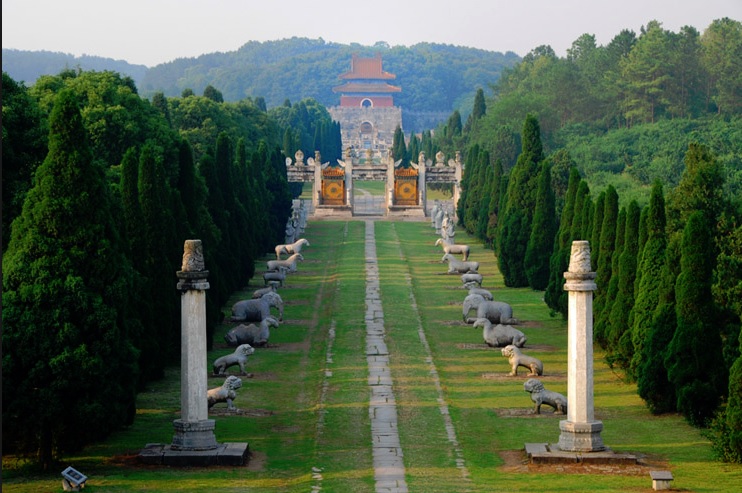
Ming Tombs.
Local Cuisine and Accommodation Nearby
When visiting the Ming Tombs, you’ll want to immerse yourself not only in the rich history but also in the local flavors and comfortable accommodations that this area offers. Here’s a glimpse into the culinary delights and lodging options nearby.
Culinary Delights
-
Peking Duck
No trip to Beijing is complete without savoring the world-famous Peking Duck. This dish features a perfectly roasted duck with crispy skin, served with thin pancakes, hoisin sauce, and sliced scallions. You can find excellent renditions of this dish at local restaurants like Quanjude near the Ming Tombs, where the chefs have perfected this culinary art over generations. -
Jianbing (Chinese Crepe)
For a quick and delicious snack, try Jianbing. This popular street food consists of a thin crepe filled with egg, scallions, cilantro, and often crispy fried crackers, all rolled up and served hot. Vendors around the tombs offer fresh Jianbing, making it a great on-the-go option between your sightseeing adventures. -
Douzhi (Mung Bean Milk)
Experience traditional Beijing flavors with Douzhi, a fermented mung bean drink that’s slightly sour and served cold. Often enjoyed with crispy fried dough sticks (Youtiao), it’s a unique local beverage to refresh you after exploring the tombs. You can find Douzhi at small eateries in the nearby Changping district. -
Zhajiangmian (Fried Sauce Noodles)
This hearty dish consists of thick wheat noodles topped with a savory sauce made from fermented soybean paste and minced meat. It’s typically garnished with fresh vegetables, providing a delightful mix of flavors and textures. Look for local noodle shops where you can savor this comforting meal at an affordable price.
Accommodation Options
-
Luxury: The Great Wall Hotel Beijing
Located about 30 minutes from the Ming Tombs, this five-star hotel offers opulent accommodations with stunning views of the Great Wall. Guests can enjoy amenities such as a spa, swimming pool, and a variety of dining options. The Great Wall Hotel is perfect for travelers seeking a lavish experience while exploring the historical sites of Beijing. -
Boutique: The Orchid Hotel
For a more intimate experience, consider the Orchid Hotel in the heart of Beijing. This boutique hotel features beautifully designed rooms that blend traditional Chinese aesthetics with modern comforts. With its personalized service and cozy atmosphere, it’s an excellent choice for travelers who appreciate a unique stay. -
Budget: Beijing 161 Wangfujing Hotel
If you’re looking for budget-friendly accommodations, the Beijing 161 Wangfujing Hotel offers comfortable rooms at an affordable price. Located close to public transportation, it provides easy access to the Ming Tombs and other attractions in Beijing. The hotel’s friendly staff and clean, simple rooms make it a solid choice for budget-conscious travelers.
Whether you’re indulging in local dishes or resting in comfortable accommodations, your visit to the Ming Tombs will be enriched by the surrounding culinary and lodging options that reflect the vibrant culture of Beijing.
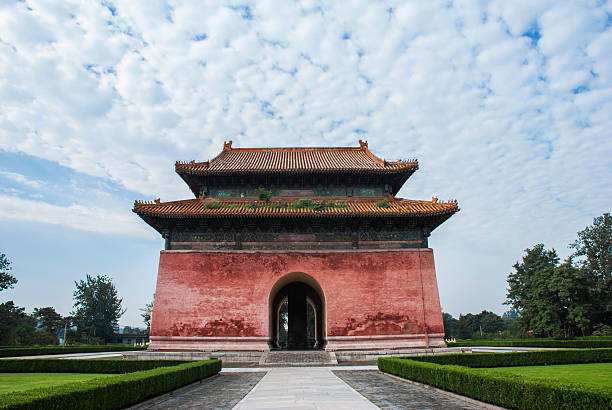
Ming Tombs.
Frequently Asked Questions
Frequently Asked Questions about the Ming Tombs
1. Is the Ming Tombs suitable for children and elderly visitors?
Absolutely! The Ming Tombs are a family-friendly destination. The paths are well-maintained, making them accessible for strollers and wheelchairs. However, it’s important to note that the underground palace of Dingling is not wheelchair accessible. For elderly visitors, it’s advisable to take breaks and pace the visit, as the site covers a large area.
2. Are there English signs and guides available?
Yes, you will find English signs throughout the Ming Tombs, making navigation easier for international travelers. Additionally, many tour guides offer services in English, providing insights and stories that enhance your experience. You can also find brochures in English at the entrance.
3. How much time should I plan for a visit?
Plan for approximately 2 to 4 hours to explore the Ming Tombs thoroughly. If you intend to visit multiple tombs, consider allocating additional time. Route 2 (Sacred Way – Changling or Dingling) takes about 2 to 2.5 hours, while Route 3 (only Changling or Dingling) takes around 1 to 1.5 hours.
4. What are the best months to visit?
The best time to visit the Ming Tombs is during the spring (April to June) and autumn (September to October) when the weather is mild, and the natural scenery is at its best. Avoid visiting during the peak summer months (July and August) due to high temperatures and crowds.
5. How do I get to the Ming Tombs from central Beijing?
The Ming Tombs are about 50 kilometers northwest of central Beijing. You can take the 872 bus from Deshengmen Station or the Changping Line subway to Ming Tomb Station, followed by a 2-kilometer walk to the Sacred Way. Alternatively, hiring a private car or joining a tour can provide more convenience.
6. Are there any entrance fees?
Yes, there are entrance fees for the different tombs. Generally, the fees are as follows: Changling Tomb costs 45 RMB (30 RMB off-season), Dingling Tomb is 60 RMB (40 RMB off-season), and the Sacred Way is 30 RMB (20 RMB off-season). A combined ticket for all three sites is available at a discounted price.
7. What facilities are available for visitors?
Facilities at the Ming Tombs include restrooms, visitor centers, and some areas with seating. There are also small shops selling snacks and souvenirs. However, it’s advisable to bring water and snacks, especially if you plan to walk for a while.
8. Can I explore the site independently, or should I book a tour?
You can certainly explore the Ming Tombs independently, as the site is well-marked. However, joining a guided tour can enrich your experience with historical context and interesting anecdotes. If you prefer a self-guided visit, consider downloading a travel app or guidebook with detailed information about the tombs and their significance.
Final Thoughts on Your Trip
As you wrap up your journey through the majestic Ming Tombs, take a moment to reflect on the rich history and cultural significance embedded within this serene landscape. Each tomb tells a story of emperors who once ruled with supreme authority, and the intricate details of their final resting places reveal the artistry and dedication of a bygone era.
Walking along the Sacred Way, surrounded by the lifelike stone statues that guard the tombs, you can almost hear the whispers of history echoing through time. The grand architecture of Changling and the mysterious depths of Dingling’s underground palace offer a glimpse into the grandeur of the Ming Dynasty, showcasing the profound beliefs in Feng Shui and the afterlife that shaped the lives of these rulers.
Whether you explore these ancient sites on your own or with a knowledgeable guide, the Ming Tombs promise a journey that transcends mere sightseeing. It’s an invitation to connect with the past, appreciate the craftsmanship, and understand the cultural heritage of China.
So, as you leave this monumental site behind, let the experience linger in your heart and mind. Carry with you the stories of the emperors, the beauty of the landscape, and the enduring legacy of a dynasty that shaped the course of Chinese history. We hope this journey inspires you to continue exploring the rich tapestry of cultures and histories that our world has to offer. Safe travels!